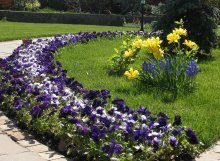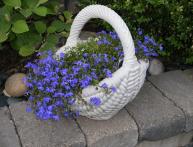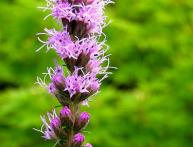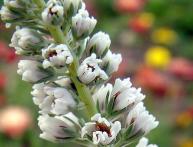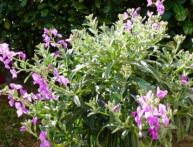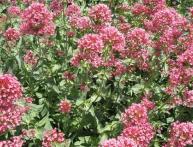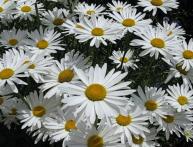Flower beds of continuous flowering: creation, proper care
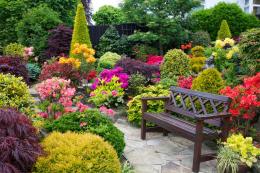
How we admire flower beds that bloom all year round, and they are so enchanting that you want to make one for yourself at home. But how? But in this article we will tell you in more detail the facts necessary to create such flower beds. Having created such a flowerbed, everyone will admire your creation.
Content:
- How to make a flower bed that blooms all year round, why is this needed?
- The most common perennials for flower beds
- How to choose planting material?
- Preparing for planting soil
- Caring for the flowerbed after planting
How to make a flower bed that blooms all year round, why is this needed?
Flower beds of continuous flowering are a year-round admiration for beauty; the flowers are selected in such a way that at the moment some fade, others are already at the start of flowering. This is a difficult task and requires a lot of effort, since it is difficult to select flowers with the desired flowering period, as well as take into account the height of the plant and create a compatible color scheme. Necessary rules to follow when creating a continuous flower garden.
First, create a sketch of the flower bed that you want to see in the future. The next step is to select a place for the future flower garden. It should be with partial shade, since it is worth taking into account the fact that some flowers are shade-loving, while others are not. When choosing a place for a flower garden under the sun, there is a chance to destroy some of the plants before they begin to actively bloom.
When planning the placement of flowers in a flower bed, take into account their size and color.It is better to plant flowers in groups, adhering to the following scheme: tall We plant flowers in the background, and low ones go to the foreground. With this layout, the flowers will not overlap each other.
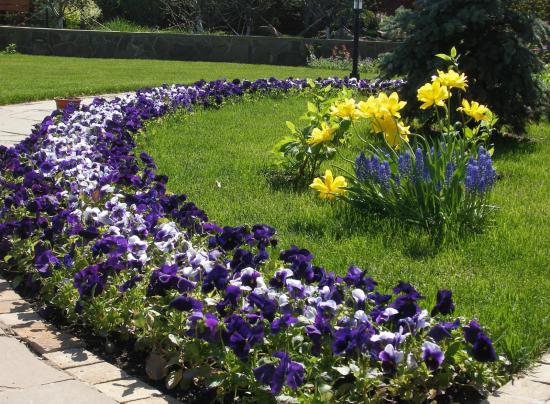
When distributing the color spectrum of plants, it is also better to adhere to the same scheme, with brighter colors (blue, red) in the background, and calmer colors (pink, blue, orange) in the foreground. When planting a flower bed with flowers, do not forget that primroses should be planted in the fall. Perennial plants should also be sown in advance. In addition, do not forget about coniferous bushes, which are basic and decorate the flowerbed regardless of weather conditions and time of year.
Caring for an already formed flower bed includes timely watering and, as weeds grow, removing them, because they interfere with the growth of planted flowers. When cutting flower heads, do not spare them, as the plant must “renew itself” in order to bloom more luxuriantly and brightly next year. Remove dried flowers, they spoil the entire appearance of the flowerbed and prevent the remaining flowers from growing fully.
The most common perennials for flower beds
With the onset of warmth, everything comes to life and primroses appear. These flowers are worth planting in your flowerbed. As an example, we bring to your attention:
- primrose
- margarita
- pansies
- hyacinth
- grouse
These annuals will decorate the flowerbed, outshining the empty spaces, and they will bloom at the end of summer. When summer is in full swing, perennials will begin to bloom, so when planting them, think carefully about a place for them in the flowerbed. The following plants bloom in early summer: roses and calendula, liatris and alyssum. Of course, you can plant other flowers that suit your taste.
In August, cornflowers, lilies and erigeron begin to bloom. Summer gives way to autumn. This means that the following flowers come into life, which easily tolerate the cold. These are phloxes, chrysanthemums, Septembers and Octobers. In addition, it is possible to re-bloom planted plants, for example, roses.
Do not forget during the flowering period it is necessary to remove faded inflorescences and dried bushes. Some people like to plant decorative onions in a flowerbed; they decorate the flowerbed right up to the onset of frost. For those who love white flowers, we suggest planting asters or sage.
Even if you plant the plants that we suggested to you, the flowerbed will delight you for several seasons, but it is worth plant them correctly so that they harmoniously combine with each other.
How to choose planting material?
Mandatory conditions for planting perennials are the same requirements for care and the selected soil. When purchasing perennial seeds, think through to the smallest detail what kind of flower bed you want to have. Draw a diagram in advance or find a ready-made one on the Internet that you like. This will help you decide on planting material.
When creating a design, consider the height of the desired plants, whether they can grow, and their color. Before planting, learn how to properly plant perennials, since each plant has its own approach. Some may be planted directly into the ground, while others require growing seedlings. Find out which species can be left in the ground over the winter and which need to be dug up.
Preparing for planting soil
Having decided on the location of your flower garden, you need to take care of the soil. First, clean it of unnecessary items and weed. If there is heavy soil, lighten it by adding sand, otherwise mix it with clay soil. Next, add compost to the soil to make it more fertile.
In addition, with compost, it becomes breathable and retains moisture more. Compost is an essential component for creating soil for sowing plants. For plants to grow well in this soil, it must be cultivated.
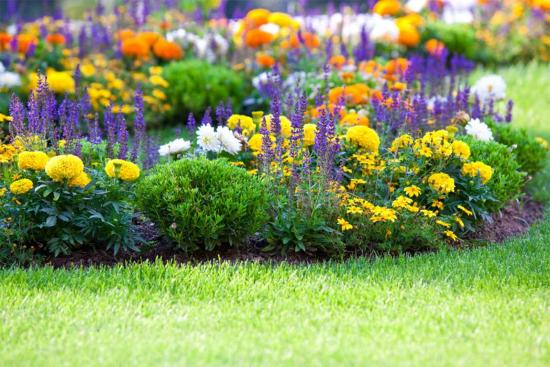
Loosen it, so the roots will feel more comfortable and take root faster. You need to loosen it 30 centimeters deep, add fertilizer as you loosen it. If you choose to plant a flowerbed with perennial plants, apply organic fertilizer as a fertilizer. Fertilizers should be applied in the spring at the time of tillage. Apply fertilizers according to the instructions included with it.
Caring for the flowerbed after planting
A flowerbed of continuous flowering requires some care, because various plants are planted on it. However, when choosing plants, you should try to choose similar care requirements for flower growth. In addition to regular watering, you should follow other rules for caring for a flower garden. soil it is necessary to loosen systematically.
This action should be done either in the morning or in the evening. This approach will have a better effect on plant growth. Remove dried leaves and inflorescences in a timely manner so that they do not interfere with the growth of other plants and do not spoil the appearance of the flowerbed. If, after harvesting wilted plants, a space appears, it can be hidden with a decorative stone. This will add innovation to the flowerbed.
If plants that love warmth are planted, you should take care of their insulation or shelter for the winter.Do not use leaves for this, they will not warm the plant and it will die. Do not forget to feed perennial plants, then their growth will be faster. By following our tips, you will create a beautiful flower garden of continuous flowering. It will become your pride, which you will gladly want to show to everyone. We wish you good luck in this matter, everything will work out for you if you really want to.
Video about a flowerbed of continuous flowering:

